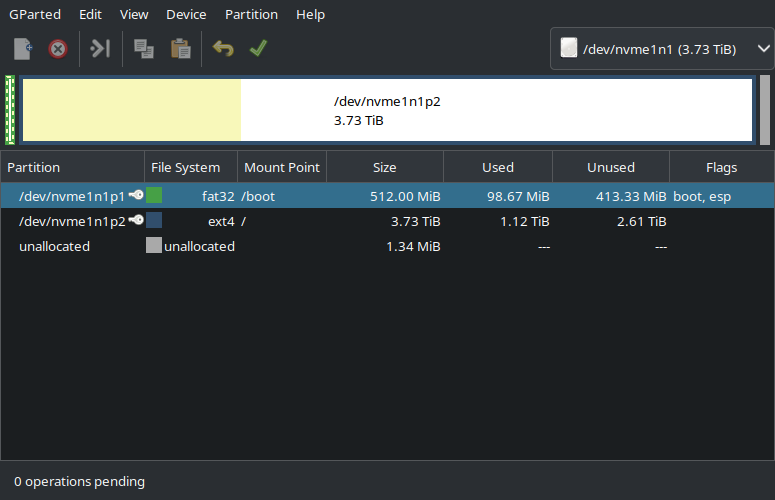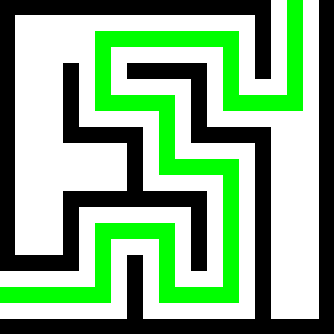How did you partition your disk before installing Linux? Do you regret how you set it up?
I’m looking for some real users experiences about this and I’m trying to find the best approach for my setup.
Thank you for sharing!
In 20 years of using Linux my partition scheme has always been to say yes to whatever the OS suggests.
It’s usually that way for a reason, is my thinking
whatever the OS suggests.
Ew. Then you get XFS.

Just used the default for one big partition. I used to do tedious partition configurations, but it always ended up biting me down the road more than helping. This drive is for the OS, games, and working files. I have a 16TB NAS that holds anything worth saving, so if I need to nuke the whole thing and do a reinstall, all I really end up doing is downloading a bunch of Steam games again.
This gives basically no headaches at all. I am running this schema on all my Linux devices. And swap is done using a swapfile instead of a partition. This way, you can easily increase it later on.
~500 MB for /boot and the rest is LUKS-encrypted btrfs
Defaults are usually fine for most users. People who know they are going to distro hop or need to move data later should have a separate
/home, but that’s about it until you get into special purpose installs.- 550MiB /boot (also used as esp)
- Rest for / (btrfs)
- Subvols for /home, /var/log, /var/cache, /.snapshots (snapper snaps), /swap
I just chose the automatic partition thingy ¯\_(ツ)_/¯
Just recently repartitioned my MacBook:
1 GB for EFI (vfat)
2 GB for /boot (ext4)
11 GB for swap
224 GB for / (bcachefs)
Grub cannot load a kernel off bcachefs so I need ext4 to bridge the gap. Once the kernel is loaded, it has no problem using bcachefs as root.
This is a laptop. On a desktop that can handle more drives, I would split /home onto a drive of its own.
For my desktop, I have two disks. One is root, one is home. They are single BTRFS filesystems with automated snapshots, compressions, and a few subvolumes. Works great.
For a laptop, similar but with only a single disk/partition and FDE. Also works well.
In my first install I had different home and root partitions. That was a big mistake. Once set, you cannot resize them properly and you are fucked if they are not perfect for your need. In my case the root partition got to small. After some time I just reinstalled with a single partition and would do that again.
Once set, you cannot resize them properly
This is untrue.
I’ve resized and moved partitions on a remote host during a reboot – i.e. doing the change in a batch during that boot.
It’s possible, and for most other resizes it’s easy enough and worth it for the benefits. Do you want to do it daily? No. Do you want to half-ass it and not pay attention during? Also no.
Two separate EFI boot Partitions if you dual boot. Its not worth letting Windows know about linux. Linux chainloads to Windows boot.
I’ve been using Linux for over a quarter of a century. Initially I spent hours attempting to come up with the best partitioning scheme but these days I pick LVM and use the defaults.
If I run out of space, I add a drive (or grow the virtual one) and grow the filesystem into the extra space.
Sometimes I need temporary space and use sshfs to mount a directory from another machine.
In other words, today you have infinite options to adjust according to need, partition schemes are not nearly as important.
Even swap space can live as a file on a normal partition if required.
That said. If you have specific use cases, check what’s required. Specifically because different uses need different attributes, it pays to check.
save 80gb for root, sone swap (if not on an ssd) rest for /home. that way reinstalling or switching has minimal risk of losing my /home
I enjoy the way OpenSuse Tumbleweed set it up:
Laptop:
NAME MAJ:MIN RM SIZE RO TYPE MOUNTPOINTS nvme0n1 259:0 0 476.9G 0 disk ├─nvme0n1p1 259:1 0 1G 0 part /boot/efi └─nvme0n1p2 259:2 0 475.9G 0 part └─cr_nvme-eui.044a5011215f41f7-part2 254:0 0 475.9G 0 crypt ├─system-root 254:1 0 168G 0 lvm /var │ /usr/local │ /srv │ /root │ /opt │ /boot/grub2/x86_64-efi │ /boot/grub2/i386-pc │ /.snapshots │ / ├─system-swap 254:2 0 2G 0 lvm [SWAP] └─system-home 254:3 0 305.9G 0 lvm /home $ sudo fdisk -l Disk /dev/nvme0n1: 476.94 GiB, 512110190592 bytes, 1000215216 sectors Disk model: UMIS RPIRJ512VME2OWD Units: sectors of 1 * 512 = 512 bytes Sector size (logical/physical): 512 bytes / 512 bytes I/O size (minimum/optimal): 512 bytes / 512 bytes Disklabel type: gpt Device Start End Sectors Size Type /dev/nvme0n1p1 2048 2099199 2097152 1G EFI System /dev/nvme0n1p2 2099200 1000215182 998115983 475.9G Linux LVMDesktop:
NAME MAJ:MIN RM SIZE RO TYPE MOUNTPOINTS nvme0n1 259:0 0 931.5G 0 disk ├─nvme0n1p1 259:1 0 512M 0 part /boot/efi └─nvme0n1p2 259:2 0 931G 0 part └─cr-auto-1 254:1 0 931G 0 crypt ├─system-root 254:2 0 610G 0 lvm /var │ /usr/local │ /root │ /srv │ /opt │ /boot/grub2/x86_64-efi │ /boot/grub2/i386-pc │ /.snapshots │ / ├─system-swap 254:3 0 62.5G 0 lvm [SWAP] └─system-home 254:4 0 1.2T 0 lvm /home nvme1n1 259:3 0 931.5G 0 disk └─nvme1n1p1 259:4 0 931.5G 0 part └─cr-auto-2 254:0 0 931.5G 0 crypt └─system-home 254:4 0 1.2T 0 lvm /home $ sudo fdisk -l /dev/nvme?n1 Disk /dev/nvme0n1: 931.51 GiB, 1000204886016 bytes, 1953525168 sectors Disk model: WD_BLACK SN850X 1000GB Units: sectors of 1 * 512 = 512 bytes Sector size (logical/physical): 512 bytes / 512 bytes I/O size (minimum/optimal): 512 bytes / 512 bytes Disklabel type: gpt Device Start End Sectors Size Type /dev/nvme0n1p1 2048 1050623 1048576 512M EFI System /dev/nvme0n1p2 1050624 1953525134 1952474511 931G Linux LVM Disk /dev/nvme1n1: 931.51 GiB, 1000204886016 bytes, 1953525168 sectors Disk model: WD_BLACK SN850X 1000GB Units: sectors of 1 * 512 = 512 bytes Sector size (logical/physical): 512 bytes / 512 bytes I/O size (minimum/optimal): 512 bytes / 512 bytes Disklabel type: gpt Device Start End Sectors Size Type /dev/nvme1n1p1 2048 1953525134 1953523087 931.5G Linux LVMwhat command did you use to get that tree view, I thought it was a df flag but its not.
Oh I didn’t notice I didn’t include the command (twice!).
It’s
lsblkwithout any arguments.Thank you. Odd it doesnt show network attached storage (I was going to use this method to show my partitions but I have like 3 NFS drives I use for personal, med, and long term storage)
Oh yeah, because it stands for
list block devices
For Laptops:
- 500 MB - /boot/efi
- 1 GB /boot ext2
- X GB for / with Luks2 encrypted f2fs
And don’t forget: GPT not MBR.
I have a separate boot partition so the rest can be encrypted with luks. That’s all that’s needed in a large majority of scenarios. Most other setups end up needing to resize something at some point which in many cases is a total pain.
On my primary PC I do have a second hard drive for documents and other long term storage files that I want to access more often than on the NAS. This way it’s nearly impossible to lose those files of I reinstall something and it can act as a temporary backup storage for settings files when I do reinstall stuff rather than having a partition that wastes space or runs out of space.






